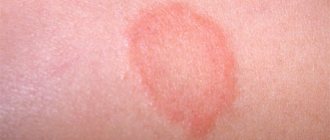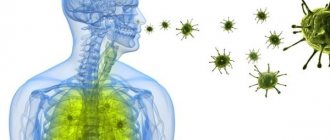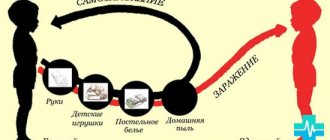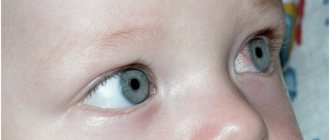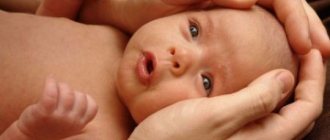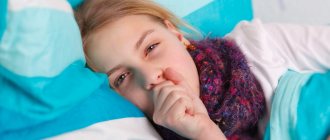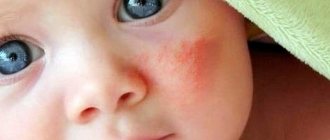Dermatovenerologist
Khasanova
Alina Rashidovna
8 years of experience
Make an appointment
Pityriasis rosea has many names in medicine. It is called roseola exfoliating, Gibert's disease, pityriasis rosea. The disease belongs to the infectious-allergic category of dermatoses, is of an acute inflammatory nature with the appearance of spotty, papular, erythematous-squamous lesions. They are located mainly on the torso and on the surface of the limbs. Most often, Zhiber's pink lichen is diagnosed in women aged 20 to 40 years, as well as in adolescents. In other age categories of people, the disease is extremely rare. The peak of complaints occurs in spring and autumn during the spread of acute respiratory diseases.
Causes of pityriasis rosea in a child
The possibility of pityriasis rosea in infants is due to weak immunity, which is just being formed, but these cases are quite rare; school-age children and teenagers are more often susceptible to pityriasis rosea.
The exact cause of pityriasis rosea has not been identified, but there are several reasons that increase the risk of this disease:
- A sharp decrease in immunity - may be due to recent vaccination, the presence of chronic diseases, constant use of medications, frequent colds, the autumn - spring period, at this time the body's defenses in children decrease;
- Allergic reaction - for example, during the introduction of the first complementary foods, wearing things made of synthetic fabrics, taking medications that often cause allergies in infants;
- High emotional or physical stress, frequent stress;
- Hypothermia;
- Overheat;
- Frequent injuries that disrupt the barrier functions of the skin;
- Using rough washcloths or aggressive hygiene detergents.
Pityriasis rosea in adolescent children can be caused by herpes viruses type 6 and 7, and in infants the presence of streptococcus, these pathogens can cause allergies, which will manifest as red spots.
Pityriasis rosea is considered not an infectious disease, but in medical practice there are precedents when the whole family was exposed to this type of lichen, perhaps due to the fact that bedbugs and ticks can be carriers of this infection.
Find out more
Symptoms of pityriasis rosea in a child
You can see the signs of lichen deprivation in children in the photo section.
Pityriasis rosea is characterized by a clear clinical picture, but develops in stages:
- Pre-initial stage - General deterioration in condition, body aches, sometimes swollen lymph nodes, joint pain, in some cases increased body temperature and decreased appetite, can be confused with the onset of the flu, but in addition to these symptoms you can add numbness or tingling of the skin in which the first outbreak will appear in the future.
- Initial stage - Formation of a “maternal” plaque (a round-shaped spot, has a scarlet tint, up to 10 centimeters in size, is covered with small scales, has a small depression in the middle, which has a lighter color) is localized on the upper part of the body - on the shoulders, shoulder blades or chest.
- Second stage - A week after the appearance of the “maternal” plaque, numerous rashes appear on the body, which diverge and can be localized throughout the body, often along the “Langer lines” (conventional lines indicating the direction of skin tension), but including the hands, feet and hair. They have different sizes, the lesions can be from 1 to 4 centimeters. The lesions are pink and peel, causing the skin to become dry and itchy.
- Final stage - Due to the rejection of the scales, white spots remain in place of the previous lesions, the scarlet edges of the affected areas change their color, becoming lighter.
Pityriasis rosea goes away completely within 2 to 4 weeks, and traces of spots disappear completely after another 5 weeks.
Pityriasis rosea in infants may appear without the formation of a “maternal” plaque, being located more on the face (cheeks).
There are atypical forms of the disease, in which small pimples, nodules and ulcers may occur, this depends on the characteristics of the body, treatment will take longer.
Diagnosis of pityriasis rosea in a child
Before starting treatment for pityriasis rosea, it is important to make a correct diagnosis. If you notice red spots on your child's skin that are flaky and accompanied by itching, you should visit your pediatrician and he will give you a referral to a dermatologist.
Basically, a simple examination is enough for the doctor, but in addition he can perform dermatoscopy (a non-invasive research method using a tenfold magnification of the problem area).
In very rare cases, for example, if the affected area is scratched, a secondary infection has developed and scraping (sampling of epithelial particles for histological analysis) may be required.
Laboratory tests will also be taken - a general blood and urine test.
It is very important to visit a doctor, because pityriasis rosea can be externally confused with diseases such as rubella, which is also common in babies, or different types of dermatitis - which have similar symptoms.
Help from a dermatologist in Moscow
Diagnosis and treatment of pityriasis rosea is the field of activity of a dermatologist. Depending on the form of the disease and the extent of skin damage, the patient is provided with recommendations. With lichen, the emotional and psychological background of a person is important, so promptly making a correct diagnosis allows you to quickly overcome the disease.
You can make an appointment with a dermatologist at Meditsina JSC (academician Roitberg’s clinic) by phone. You should not self-medicate. The reason is that, according to external signs, skin rashes may turn out to be differential diseases, for example, toxicerma, psoriasis, mycosis, secondary syphilis. In these cases, it is necessary to prescribe another therapy, taking into account the specific clinical picture and medical history of the patient.
Treatment of pityriasis rosea in a child
Due to the factors in the development of pityriasis rosea, it does not require any special treatment.
Often this is a symptomatic treatment, that is, when the temperature rises, antipyretic drugs are indicated, because of severe itching that causes severe discomfort, anti-allergic drugs are prescribed.
If a child’s lichen occurs due to frequent colds, the doctor will recommend taking a complex of vitamins, and if the temperature rises, a course of antibiotics.
In cases where lichen causes severe discomfort due to itching, anti-inflammatory ointments are indicated.
Pityriasis rosea in an infant caused by allergies should not be treated only by taking antihistamines; it is much more important to remove the allergen completely and replace medications with hypoallergenic ones.
Sorbent preparations are also indicated to remove accumulated allergen from the body; skin manifestations will go away faster. During the course of the disease, replace all detergents with a suitable pH level for the baby.
Due to the very young age of patients, some medications may be contraindicated, then folk remedies can come to the rescue, but all of them must be discussed with the attending physician!
They help reduce the feeling of itching and will help the main treatment, but should be used with caution.
Diagnostics
Diagnosis of pityriasis rosea is largely based on examination of the patient and analysis of the information received. The staged nature of the appearance of the rash and its characteristic features direct the search in the necessary direction. To confirm the diagnosis of pityriasis rosea, the doctor prescribes several additional tests:
- blood test according to standard methods. The inflammatory process in a child’s body is characterized by the appearance of typical changes: the number of immune cells of leukocytes increases, the ESR increases;
- Blood serum is necessarily sent for analysis of antibodies to the causative agent of syphilis. If the result is negative, the diagnosis of pityriasis rosea becomes more likely;
- To exclude the fungal nature of the disease, a scraping is taken from the plaques. The resulting material (mainly horny scales) is examined for the presence of mycelium - a specific formation that serves for the life and reproduction of fungi;
- in doubtful cases, including with an atypical form, a histological examination of the affected skin area under a microscope is used. This method allows you to distinguish pityriasis rosea from other diseases with a similar picture.
To diagnose pityriasis rosea in doubtful cases, histological examination is used
Pityriasis rosea must be distinguished from the following diseases:
- mycosis of smooth skin. This pathology is caused by pathogenic species of fungi (Microsporum, Trichophyton);
- syphilis. The infectious nature of this disease has been proven. The causative agent - Treponema pallidum - is transmitted through sexual contact and in utero from mother to child;
Syphilis is a dangerous infectious disease - guttate psoriasis. This disease is characterized by the formation of plaques that differ in appearance from the elements of pityriasis rosea;
- coin-shaped dermatitis. Rashes with this disease are localized on the hands and feet;
- lichen planus. Bulk elements are localized on the wrists, purple in color;
Lichen planus is accompanied by the formation of plaques on the skin - seborrheic dermatitis. Plaques are located mainly in the area of hair growth and skin folds.
Treatment of pink lichen in a child with folk remedies
Let's consider several methods (you should not apply the tips given without consulting a doctor):
- Herbal decoctions - you can buy herbal infusions at the pharmacy, often calendula, celandine and birch buds. These herbs have an antiseptic and anti-inflammatory effect. They are used as lotions or added while taking a bath.
- There are many methods using acetic acid, garlic or menthol; you should be careful with such recipes because they can cause pain and leave burns.
- You can also use oils of various herbs, it is highly undesirable to follow these tips, the skin on which the oils are applied does not allow oxygen to pass through, inflammation may begin and will only worsen the situation.
- And the use of ashes from newspaper sheets is fraught with the addition of infections.
Be careful about traditional medicine.
There are alternative treatments, but they should be complementary and not the primary treatment:
- Using clothing made from natural fabrics (which will eliminate the possibility of allergies to synthetic fabrics);
- A properly selected diet that excludes allergens;
- Carry out general cleaning, paying special attention to carpets or large soft toys (they may contain ticks that can be a source of infection);
- Iron all of the child's underwear and bedding.
After complete recovery, relapses do not occur. A child who has had pityriasis rosea develops immunity to this disease.
Prevention of pityriasis rosea in children
For a speedy recovery or to prevent infection, you should follow a few simple rules that will help you avoid not only pityriasis rosea, but also other unpleasant skin diseases:
- From an early age, instill in children a culture of personal hygiene; all household members should have their own personal hygiene items - elastic bands, combs, slippers, towels, etc.;
- Strengthen the child's immunity - by hardening, maintaining a healthy lifestyle, taking vitamins, especially in the autumn - spring period, for children who are susceptible to frequent respiratory diseases and visiting institutions with a large number of people
- Avoid hypothermia and overheating
- Avoid allergens
- Strengthen the nervous system, especially for adolescent children, due to possible strong mental or emotional stress
- Avoid prolonged exposure to sunlight, sweat getting on the lesions can cause even more severe itching and contribute to the appearance of new spots
- Do not use ointments, lotions, creams containing sulfur or tar; these components dry the skin, causing additional discomfort, and also limit the removal of toxins.
Even if you have classic symptoms, do not self-medicate, trust your doctor, then the treatment will be effective and the disease will go away faster.
Causes
Despite the apparent similarity of both diseases, their causes are different. It has been proven that ringworm is caused by anthropophilic fungi. Microscopic fungal pathogens can travel not only across the skin, but are also carried with lymph throughout the body.
The disease is highly contagious. You can get it from three sources:
- From another person
- From an animal
- Through household items
Infection from animals is the most severe and the most difficult to treat. And if not noticed in time and not treated, it can become chronic.
Zhiber's lichen or simply pink appears in children of the first year of life very rarely and always against the background of immune shocks. Its exact causative agent is unknown, but scientists are inclined to believe that it is a virus similar to herpes. The viral nature is confirmed by similar symptoms to respiratory diseases, and by the fact that after a person has lifelong immunity to the disease. And the fact that pityriasis rosea goes away on its own after a month or two indicates the same thing.
The causes of Zhiber's deprivation necessarily include the immune weakness of children at the time of the disease. The trigger may be the transition from breast milk to formula or the beginning of complementary feeding. The allergic component also comes into play here. Therefore, when this type of deprivation appears in a baby, the start of complementary feeding is postponed to a later time and any load on the immune system is reduced.

